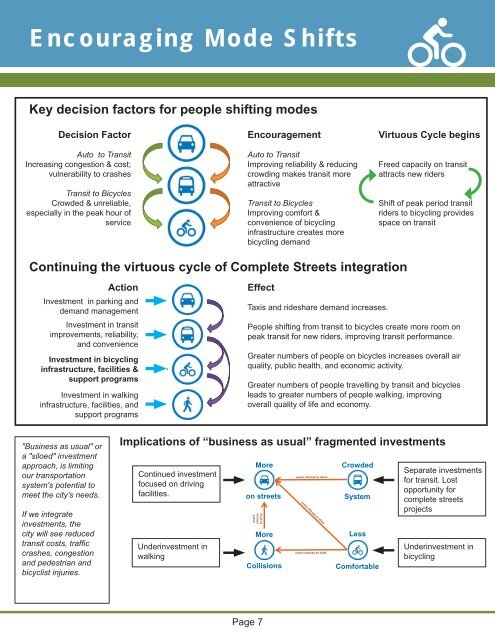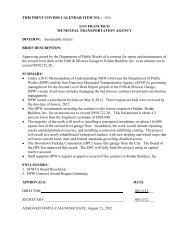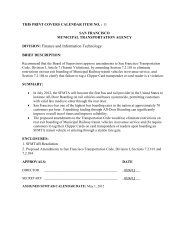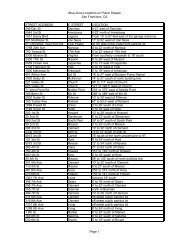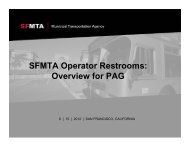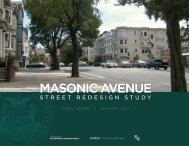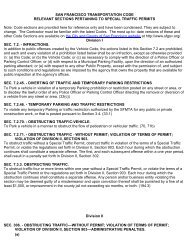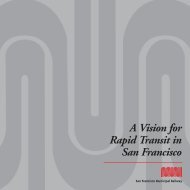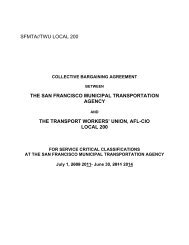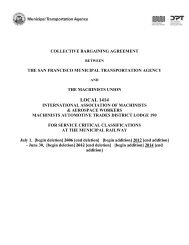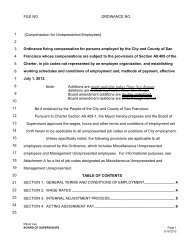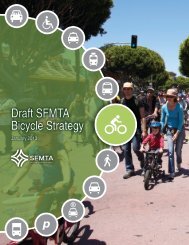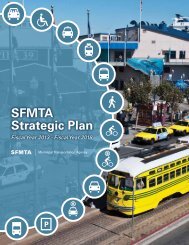Download Report - San Francisco Municipal Transportation Agency
Download Report - San Francisco Municipal Transportation Agency
Download Report - San Francisco Municipal Transportation Agency
You also want an ePaper? Increase the reach of your titles
YUMPU automatically turns print PDFs into web optimized ePapers that Google loves.
Encouraging Mode Shifts<br />
Key decision factors for people shifting modes<br />
Decision Factor<br />
Auto to Transit<br />
Increasing congestion & cost;<br />
vulnerability to crashes<br />
Transit to Bicycles<br />
Crowded & unreliable,<br />
especially in the peak hour of<br />
service<br />
Encouragement<br />
Auto to Transit<br />
Improving reliability & reducing<br />
crowding makes transit more<br />
attractive<br />
Transit to Bicycles<br />
Improving comfort &<br />
convenience of bicycling<br />
infrastructure creates more<br />
bicycling demand<br />
Virtuous Cycle begins<br />
Freed capacity on transit<br />
attracts new riders<br />
Shift of peak period transit<br />
riders to bicycling provides<br />
space on transit<br />
Continuing the virtuous cycle of Complete Streets integration<br />
Action<br />
Investment in parking and<br />
demand management<br />
Investment in transit<br />
improvements, reliability,<br />
and convenience<br />
Investment in bicycling<br />
infrastructure, facilities &<br />
support programs<br />
Investment in walking<br />
infrastructure, facilities, and<br />
support programs<br />
Effect<br />
Taxis and rideshare demand increases.<br />
People shifting from transit to bicycles create more room on<br />
peak transit for new riders, improving transit performance.<br />
Greater numbers of people on bicycles increases overall air<br />
quality, public health, and economic activity.<br />
Greater numbers of people travelling by transit and bicycles<br />
leads to greater numbers of people walking, improving<br />
overall quality of life and economy.<br />
"Business as usual" or<br />
a "siloed" investment<br />
approach, is limiting<br />
our transportation<br />
system's potential to<br />
meet the city's needs.<br />
If we integrate<br />
investments, the<br />
city will see reduced<br />
<br />
crashes, congestion<br />
and pedestrian and<br />
bicyclist injuries.<br />
Implications of “business as usual” fragmented investments<br />
Continued investment<br />
focused on driving<br />
facilities.<br />
Underinvestment in<br />
walking<br />
More<br />
on streets<br />
users<br />
choose<br />
to drive<br />
More<br />
Collisions<br />
users choose to drive<br />
users choose to walk<br />
Crowded<br />
System<br />
Less<br />
Comfortable<br />
Separate investments<br />
for transit. Lost<br />
opportunity for<br />
complete streets<br />
projects<br />
Underinvestment in<br />
bicycling<br />
Page 7


